©
2004 Jeff Matthews & napoli.com
Municipio,
Piazza
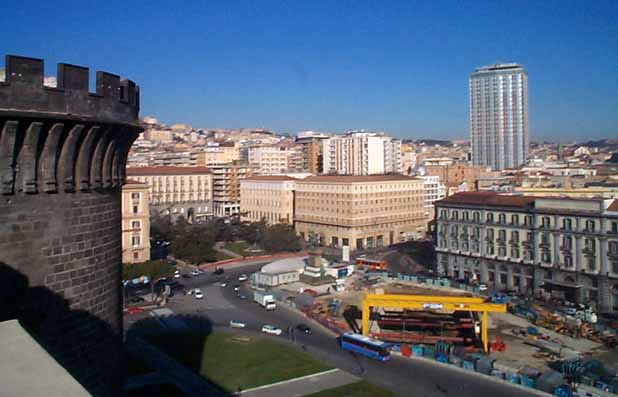 The importance in Naples of Piazza Municipio—City
Hall Square—goes back to the days of the Angevins, when the Maschio
Angioino, the New Castle, was built. The castle and area around it
thus became the symbol of authority. Besides the castle, a new Angevin
harbor was built on the sea directly in front of the castle. Later, the
Aragonese and then the Spanish expanded the fortifications, such that
at its height, the castle housed the royal armory, foundry and the corps
of the Royal Guards, essentially taking up most of the space of the present-day
square. In the late 1800s, the urban renewal
of Naples started to give shape to the area around the castle and
began to transform it into the Piazza Municipio we see today. (This
photo looks down on Piazza Municipio from the Maschio Angioino. The center
of the square is cluttered with construction equipment for the new subway
station.) The importance in Naples of Piazza Municipio—City
Hall Square—goes back to the days of the Angevins, when the Maschio
Angioino, the New Castle, was built. The castle and area around it
thus became the symbol of authority. Besides the castle, a new Angevin
harbor was built on the sea directly in front of the castle. Later, the
Aragonese and then the Spanish expanded the fortifications, such that
at its height, the castle housed the royal armory, foundry and the corps
of the Royal Guards, essentially taking up most of the space of the present-day
square. In the late 1800s, the urban renewal
of Naples started to give shape to the area around the castle and
began to transform it into the Piazza Municipio we see today. (This
photo looks down on Piazza Municipio from the Maschio Angioino. The center
of the square is cluttered with construction equipment for the new subway
station.)
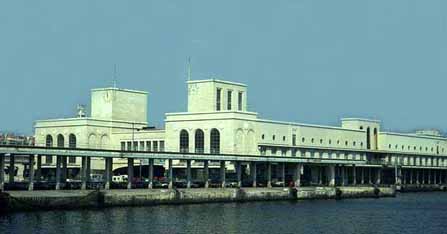
Much
of the transformation had to do with enlarging the port area and building
new facilities for shipping. The final touch in that transformation
didn’t come until the construction of the new Maritime Passenger
Terminal (photo, right) in 1939. It is of the same monolithic architecture
as the main Post Office, also a product of architecture under Fascism.
Large and imposing, they represent the last great building splurge in
Naples until the very recent investment in skyscraper technology in
the new Civic Center at the extreme east end of town.
The clearing of the area around the port during the 1890s affected Piazza
Municipio and the entire east-west axis along the old port, doing away
with many of the buildings from the 1700s and leaving intact only a
few bits and pieces of the old city wall for reasons of historical interest
(one of which is the nearby Church of the
Incoronata on via Medina). The present day Municipio (City
Hall) (seen, partially hidden, in the center of the top photo) at the
north end of the square is called Palazzo
San Giacomo because it incorporates an ex-monastery
of that name built by the Spanish in the 1500s. (The adjacent church
of the same name still functions as a church.) The Municipio, itself,
dates back only to the early 19th century. It was an example of advanced
architectural technology at the time, utilizing glass for an internal
passageway that connected the square in front with the main street,
via Toledo in the rear. That advantage was undone by the recent construction
of the Bank of Napoli on via Toledo, effectively closing the passage.
Thus, the entire square, from the port to the Municipio is spacious
and grand, and it was from here that the urban renewal of Naples in
the late 1800s started.
Virtually
all of the buildings, including the nearby Galleria Umberto represent the new idea at the turn-of-the-century
of building shop and office space for the middle-class. From Piazza
Municipio, then, the clearing continued to the east down to Piazza
Bovio where the beginning of a new broad avenue, Corso
Umberto, would be built.
The current
(2003) excavation and contruction in the middle of the square is for
the "Municipio" stop of the new underground Metropolitana train line.
It will connect to stops further east at Piazza della Borsa,
then via Duomo, and, finally, the central train station at Piazza
Garibaldi, essentially running parallel to and over the walls of
the ancient Greco-Roman city of Neapolis. What is now Piazza Municipio
was well outside those walls, but, nevertheless, the digging has uncovered
some interesting archaeological finds, including the outer fortifications
of the fortress, erected by the Spaniards in the 1500s.
Evil
eye, luck (good & bad) (3), malocchio
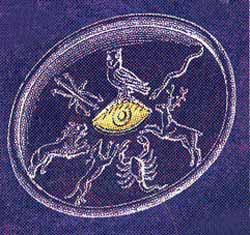 I
came across this interesting item in the on-line version of the 1911
Encyclopaedia Britannica. In the section on Naples, there is
a paragraph about folk-lore and, specifically, how Neapolitans ward
of the "evil eye": I
came across this interesting item in the on-line version of the 1911
Encyclopaedia Britannica. In the section on Naples, there is
a paragraph about folk-lore and, specifically, how Neapolitans ward
of the "evil eye":
| ...charms
against the Evil Eye...were all derived from the survival of ancient
classical legends... These may be divided into three classes:
first, the sprig of rue in silver, with sundry emblems attached
to it, all of which refer to the worship of Diana, whose shrine
at Capua was of considerable importance; secondly, the serpent
charms, which formed part of the worship of Aesculapius, and were
no doubt derived largely from the ancient eastern ophiolatry;
and lastly charms derived from the legends of the Sirens...The
sea-horse and the Siren alone are commonly found as charms... |
I had never
heard any of that. There are a few terms used for "evil eye," "bad luck,"
etc. in Italian, in general, and in southern Italy, in particular. Simple
"bad luck" is sfortuna, which is about the same as "misfortune"
in English; there is no implication of it having been caused. The "evil
eye," however—malocchio, in Italian—is much different.
That is misfortune "cast" on you by a malevolent person with that particular
ability. Indeed, one of the common Neapolitan terms for that kind of
bad luck is jettatura, which comes from the Italian verb "gettare,"
meaning "throw" or "cast". Another common word in both Italian and Neapolitan
for "witchcraft" is fattura, from the root "make," or "do". (Fattura,
fittingly, is also the name for the receipted invoice you have to give
someone if you sell them something, so you can't get out of paying a
tax on your profit. Witchcraft, bad luck, taxes. I rest my case.)
In any
event, the most common way to ward off the Evil Eye, or bad luck caused
by a spell, is by making the "sign of the horns"—le corna—(see here), that is, extending the index and little
fingers of the hand and waggling your hand towards the ground. You can
also buy a lucky charm in the shape of a single curved horn. There are
two explanations for the use of the horns as a good luck charm: one
says that it comes from the defensive posture of animals: head lowered,
horns ready to use; the other—more likely—is that it has
to do with the sexual vigor implied in the symbol of the male animal.
Phallic symbols are also commonly seen throughout the Greek and Roman
world as good luck charms. That explanation seems more likely to me,
since another common way for men in Naples to ward off bad luck is to
touch their genitals. (Touching someone else's genitals, on the other
hand, generally causes more bad luck.) Depending on the threshold of
superstition on a given day in Naples, then, you can get some interesting
body language going on in public and broad daylight on any street in
the city.
I was not
familiar with rue—or any other plant—as a charm against
the Evil Eye. I asked a friend about this and she immediately cited
a verse to me:
"Aglio,
fravaglie, fatture ca nun quaglie...," a dialect verse meaning
"Garlic and animal innards keep away bad luck." Then, all the vampire
books and movies with which I afflicted my childhood came back to me
and I remembered about garlic. There is a whole class of plants that
are used medicinally and—in folklore—to cast spells and
ward them off. Rue (ruta graveolens) is one of them. In some
sources, it is the famous "moly plant" used by Ulysses in The Odyssey
(book 10, lines 304-6) to protect himself and his men from the spell
of the Circe. Yet, I have not seen sprigs of rue for sale on the streets
of Naples in the way that you find little horn amulets.
Serpent
charms and ophiolatry (serpent worship) are equally hard to find in
Naples. It occurs to me that some of the amulets I see in street stalls—charms
that I have always taken to be single horns—are, in fact, curved
and, if not coiled, at least "wiggly". Maybe it was originally meant
to be a snake. The only Naples myth I know about snakes has to do with
how Virgil is said to have used his magical powers to drive away a great
serpent that lived beneath the hill of the city. (See here for a relevant entry.) I am also aware
of the split in our mythology between the benevolent and malevolent
attributes of snakes. Contrasting the evil seducer/serpent in the book
of Genesis, we have in other contexts the benevolent presence of twin
serpents on the caduceus, the symbol of the medical profession, and,
further to the east, in Indian mythology, the cobra that protects Buddha
by spreading its hood over him.
I have
seen the sea-horse and siren symbols a lot in Naples, but I didn't know
that they were good luck charms—nor did any of the people I spoke
to. As they say in the ivory towers of academe: more research is needed.
Gesù
Nuovo, church & square; Santa
Chiara, church (1)

Piazza
del Gesù Nuovo may be considered the bridge between the ancient
Greco-Roman city of Neapolis and the city of the Spanish vicerealm that
was to expand to the west in the 1500s under the direction of the Viceroy
Don Pedro di Toledo. Under the earlier Angevin rule, there had been
a western gate to the city at Piazza del Gesù that the
Spanish simply moved over to Largo Mercatello (modern-day Piazza
Dante), when they built the grand avenue now known as via Toledo
(or via Roma).
The square,
Piazza del Gesù Nuovo, contains some remarkable structures.
First, there is the thirteenth-century Gothic church/convent of
Santa Chiara, marked most obviously by the belfry (photo, left) that
stands within the grounds at the end of the square. The convent was
built between 1310 and 1328 at the behest of the wife of King
Robert of Anjou. It still retains the citadel-like walls setting it
apart from the outside world, walls that contained a vast religious
community—and today contain a more modest one—made up of
the Convent of the Poor Clares and, beside it, a monastery of Grey Friars,
both dominated by the stark architecture of the church itself. The complex
was expanded along Baroque lines in the 1700s. It was almost entirely
destroyed by bombing in WW II and was restored to its original Gothic
form, retaining only a few reminders of the Baroque. King’s Robert’s
tomb is within the church, and bears the epitaph by Petrarch: Cernite
Robertum regem virtute refertum, reminding the people to “consider
Robert a King rich in virtue”.
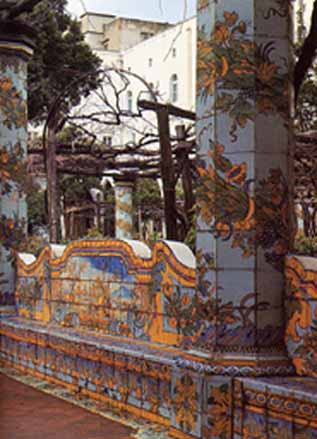
The
lovely monastic courtyard in the rear of the church is the result of
a renovation done by D.A. Vaccaro in the 1730s, apparently at the request
of Maria Amalia di Sassonia, wife of Charles III of Bourbon, King of Naples. The colorful
and delicate majolica tilework is characteristic of the school of Neapolitan
ceramic from that period and was crafted by Donato Massa and his son,
Giuseppe.
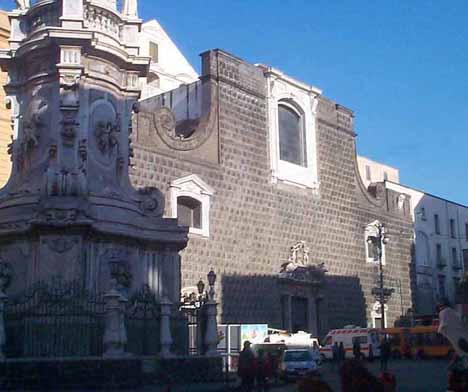 The most striking building in the square—other
than the church of Santa Chiara—is the fifteenth century residence
built for Robert Sanseverino, Prince of Salerno. It is now the Church
of Gesù Nuovo (photo, left) and has given its name to the entire
square. (It is one of those churches in Naples that started out as something
else. The word "new" in the name of the church is to distinguish it
from the church of Gesù Vecchio (old) about a half-mile away.)
The unusual façade is called "ashlar" in architectural terminology
and is one of the few examples of this characteristic 15th-century façade
in Naples.The building was finished in 1470 and was somewhat of
a symbol of the baron's increasing power and favor within the court
of Ferrante of Aragon, ruler of the Kingdom of Naples at the time. The
baron died shortly thereafter and the building passed to his son, Antonello. The most striking building in the square—other
than the church of Santa Chiara—is the fifteenth century residence
built for Robert Sanseverino, Prince of Salerno. It is now the Church
of Gesù Nuovo (photo, left) and has given its name to the entire
square. (It is one of those churches in Naples that started out as something
else. The word "new" in the name of the church is to distinguish it
from the church of Gesù Vecchio (old) about a half-mile away.)
The unusual façade is called "ashlar" in architectural terminology
and is one of the few examples of this characteristic 15th-century façade
in Naples.The building was finished in 1470 and was somewhat of
a symbol of the baron's increasing power and favor within the court
of Ferrante of Aragon, ruler of the Kingdom of Naples at the time. The
baron died shortly thereafter and the building passed to his son, Antonello.
Young Tony,
however, quickly became enmeshed in conspiracy against the throne and
was forced to flee the city of Naples and hole up in a fortress near
Salerno. He was captured and exiled to Senigallia (no, not Senegal—it's
a town on the Adriatic). His property was confiscated. He eventually
got the property back from the Spanish throne when they took over the
kingdom. The large residence then passed to his son, Ferrante. In 1547,
Ferrante incurred the wrath of the Spanish viceroy, Don Pedro Alvarez
de Toledo, and fled the kingdom, dying in Avignon, France, in 1568.
His property was put up for sale and the residence was bought by Nicolò
Grimaldi in 1584 who, in turn, sold it to the Jesuit order. It was transformed
into a church, leaving the original façade intact, and was consecrated
in 1601. The church passed to a Fransiscan order when the Jesuits were
expelled from Naples in 1767. The Jesuits got the church back in 1821.
The highly
ornamental interior of the church belies its solemn exterior. The spectacular
frescos on the ceiling of the central nave are by Belisario Corenzio
and Paolo de Matteis. Also, the church has on display The Expulsion
of Heliodorus from the Temple (1725) one of the most noteworthy
works by Francesco Solimena, the great painter of the Neapolitan Baroque.
The building,
because of its checkered history, first as a residence, then as a church—what
with people getting exiled, dying, etc. etc.—used to have somewhat
the reputation of being under an evil spell. Some students of the supernatural
have enjoyed attributing this malevolent presence to the esoteric properties
of the stones in the unusual façade.
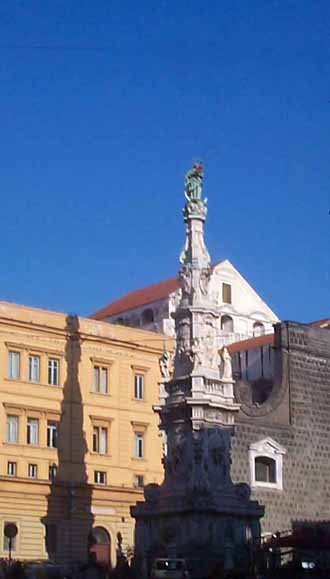 Literally "topping off’ the square is the Spire
of the Immaculate Virgin, erected in 1750 with funds collected through
public subscription sponsored by Jesuit Father Francesco Pepe. The spire
replaced an earlier equestrian statue erected in 1705 on the occasion
of a visit to Naples by Philip V of Spain. When the Spanish left the
city and were replaced by the Austrians, that statue was destroyed by
the populace. Literally "topping off’ the square is the Spire
of the Immaculate Virgin, erected in 1750 with funds collected through
public subscription sponsored by Jesuit Father Francesco Pepe. The spire
replaced an earlier equestrian statue erected in 1705 on the occasion
of a visit to Naples by Philip V of Spain. When the Spanish left the
city and were replaced by the Austrians, that statue was destroyed by
the populace.
Some of
the finest sculptors of the 1700s worked on the spire ones sees today:
among others, Francesco Pagani and Matteo Bottiglieri. Depicted on the
spire, among other scenes, are the Presentation of Jesus at the Temple;
The Birth of the Virgin Mary; and The Annunciation. The spire, itself,
represents the presence of the Jesuit Order in the city. Its rich ornamentation
is considered the epitome of Neapolitan Baroque sculpture.
Amalfi (1)—
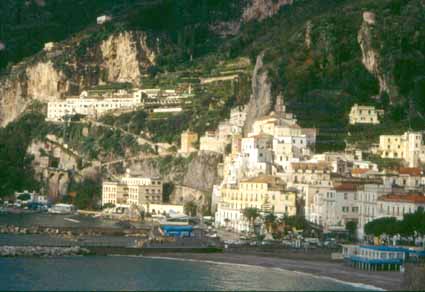 Amalfi. In 337 a.d., Roman patricians on their way to
Constantinople were shipwrecked along so stunningly beautiful a coast
that they understandably decided to stay marooned and let war and empire
pass them by. Centuries hence, the 19th century Italian writer, Renato
Fucini, would say: "When the inhabitants of Amalfi get to heaven on
Judgment Day, it will be just like any other day for them." Amalfi. In 337 a.d., Roman patricians on their way to
Constantinople were shipwrecked along so stunningly beautiful a coast
that they understandably decided to stay marooned and let war and empire
pass them by. Centuries hence, the 19th century Italian writer, Renato
Fucini, would say: "When the inhabitants of Amalfi get to heaven on
Judgment Day, it will be just like any other day for them."
For centuries
thereafter—in the turmoil following the dissolution of the Western
Roman Empire—Amalfi remained one of the small coastal enclaves
ruled nominally by the Byzantine Empire. Finally, in 839, Amalfi was
conquered by the Duchy of Benevento, itself a Longobard holdout against
Byzantium. Benevento was badly in need of a port, and though there is
little documentation of that period, the fact that Benevento bothered
to take Amalfi at all may mean that the place had already developed
into a port of some importance.
Upon the
death of the Duke, Amalfi freed itself from Benevento and went into
business for itself. In 957, the head of Amalfi took the title of Duke,
putting himself on an equal level with other rulers of the area. Little
by little, the Amalfi fleet expanded and spread throughout the Mediterranean.
Many places throughout the Mediterranean still have small churches to
Saint Andrew, patron saint of Amalfi—churches built by Amalfi
seafarers centuries ago. They established a strong presence in Antioch,
and especially Constantinople, where they were the single greatest group
of merchants in the commerce between East and West, taking an active
political and economic role in the life of the Byzantine Empire.
In Constantinople in the middle of the tenth century, there was an "Amalfi
Quarter," replete with schools and stores. And in Jerusalem the Amalfitans
founded the Order of the Knights, which later became the famous Order
of Malta.
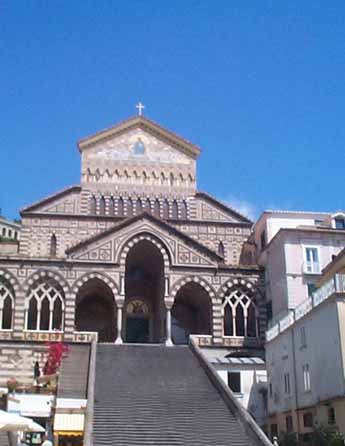 The height of the Maritime Republic of Amalfi came at about the
turn of the millennium, when Amalfi was a great exporter of wood and
iron, and importer of spices, carpets, silk, and perfumes from the Orient,
goods that found a market in the Papal States to the north and all the
cities in the south of Italy. The cathedral of Amalfi (photo, left)
is from that period. It was built in 1066 and still has the portals
imported from Constantinople (also see here).
Like the other maritime republics, Amalfi even coined its own money,
the Tarì. Also, Amalfi was where the first Maritime Code,
the so-called tavole amalfitane, was formulated, a code that
regulated maritime trade in the Mediterranean from the 1000s to the
1500s and that served as a model for future maritime law. Here,
they say, too, is where Flavio Gioia invented the compass—or at
least improved upon the device borrowed from the Arabs. The height of the Maritime Republic of Amalfi came at about the
turn of the millennium, when Amalfi was a great exporter of wood and
iron, and importer of spices, carpets, silk, and perfumes from the Orient,
goods that found a market in the Papal States to the north and all the
cities in the south of Italy. The cathedral of Amalfi (photo, left)
is from that period. It was built in 1066 and still has the portals
imported from Constantinople (also see here).
Like the other maritime republics, Amalfi even coined its own money,
the Tarì. Also, Amalfi was where the first Maritime Code,
the so-called tavole amalfitane, was formulated, a code that
regulated maritime trade in the Mediterranean from the 1000s to the
1500s and that served as a model for future maritime law. Here,
they say, too, is where Flavio Gioia invented the compass—or at
least improved upon the device borrowed from the Arabs.
The fortune
of Amalfi changed dramatically for the worse in the 1100s. Three things
happened. First, the powerful Normans, who would eventually take over
all of southern Italy to found the Kingdom of Naples, took the city
in 1131. With that, Amalfitan independence ceased. Second, the town
was sacked by the maritime competition, Pisa, in 1135 and again
in 1137. Third, Amalfi failed to participate in the first Crusade, leading
further to its decline, and to the rise of competing maritime republics
in the north of Italy. Somewhat later, in 1343, a powerful earthquake
destroyed the port of Amalfi, administering a belated coup de grace
to the once proud maritime power.
If you
visit Amalfi today, you can still see the ruins of what was the largest
naval shipyard in medieval Europe. As well, you can visit a restored
and functioning paper mill, recalling the days when the Amalfitans took
the art of paper-making from the Arabs and made it their own, turning
out precious paper products for export throughout the Mediterranean.
The tradition of nostalgic paper-making continues to this day, and you
can buy characteristic replicas of historic Amalfi letter paper, cards,
maps, etc. Also, the area—like much of southern Italy—is
marked by the presence of Saracen towers,
built to guard against incursions by the Arabs and, later, the Turks.
Worthy of attention in Amalfi is the Civic Museum, which has the only
remaining copy of the Amalfi Maritime Code, mentioned above.
The current
accessibility of Amalfi by vehicular traffic is due to the road-building
enthusiasm of Ferdinand II of Bourbon,
King of Naples, in the mid-nineteenth century, who opened a road all
along the Sorrentine peninsula and over to the Amalfi coast. (Also see
here.)
Russo,
Vincenzo
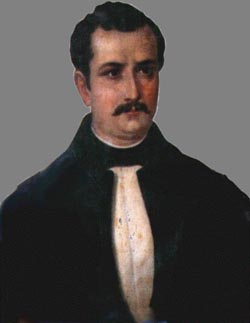 It
is not widely known that there was an active Neapolitan offshoot of
the French Enlightenment just as dedicated as mid–18th–century
French intellectuals to discussions of the Rights of Man (and even the
Rights of Woman), the decadence of monarchies, and democracy and republicanism
as societal goals worth striving for—and even worth having a revolution
for. The French Revolution is amply documented. The Neapolitan Revolution
of 1799 is not well documented—at least in English—but there
is some material in these pages: It
is not widely known that there was an active Neapolitan offshoot of
the French Enlightenment just as dedicated as mid–18th–century
French intellectuals to discussions of the Rights of Man (and even the
Rights of Woman), the decadence of monarchies, and democracy and republicanism
as societal goals worth striving for—and even worth having a revolution
for. The French Revolution is amply documented. The Neapolitan Revolution
of 1799 is not well documented—at least in English—but there
is some material in these pages:
The
Bourbons, part 1
Eleonora
Fonseca Pimentel
Cardinal
Ruffo
Two
prominent figures connected with the Neapolitan Enlightenment are discussed
elsewhere on this website: Gaetano Filangieri
and Vincenzo Cuoco . Another such person
worth mentioning is Vincenzo Russo.
Russo
was born on June 16, 1770 in Palma Campania, a small town about halfway
between Naples and Avellino. His father, Nicola, was a lawyer. His mother
was Mariangela Visciano from San Paolo Belsito. At the age of
eight, he began attending the seminary in Nola, and at 13 he went to
Naples with his brother Joseph to start his studies of the law. There
he became a member of a Masonic lodge and was attracted to the new ideas
of reform and democracy, in particular the ideals that would drive the
French Revolution. He started to attend secret meetings of the "Republican
clubs," so-called in imitation of those in France. These societies in
Naples of that period typically immersed themselves in the works of
their fellow Neapolitans, Gaetano Filangieri
and Mario Pagano* [see note, below], as well as the writings of
the likes of Montesquieu, Rousseau, Voltaire, and Locke.
When
the French fleet came to Naples in 1792 to try to gain diplomatic recognition
from the Bourbons of the French Republic, Russo was one of those who
took part in meetings with admiral Latouche Treville. Yet, with the
Bourbon monarchy running scared before potential French revolutionary
contagion in Naples, Russo was one of a number of local "republicans"
accused of conspiracy against the monarchy in 1792. Some were
actually executed, but he was let off. Later, in 1797, under the similar
circumstances of what was apparently an active Jacobin conspiracy within
the kingdom, he was forced to flee the kingdom.
He
took refuge in Switzerland where he took up the study of medicine. He
moved to Milan and then Rome and was in that city when the Roman Republic
was declared in February of 1798. He wrote for the Monitore di Roma.
He took a radical and anticlerical line. When Ferdinand IV of Naples
decided to march north and liberate the Roman Republic, Russo enlisted
as a doctor in a company of Neapolitan exiles serving in the French
army. The Bourbon army was routed in the field and fled back to Naples,
pursued by the French, which episode eventually led to the flight of
the royal family to Sicily and the proclamation of the Neapolitan Republic
in January 1799. At that point, Russo became active in the government
of the Republic and was appointed elector for the Volturno region. On
Feb. 10, because of his exceptional skill as a speaker, he was put in
charge of the ministry of public instruction for the new republic, charged
with explaining the actions of the government to the average citizen
and with encouraging political discussion.
He
was put in charge of organizing resistance in Calabria to Ruffo's royalist Army of the Holy Faith that eventually
overthrew the Republic, and he was in the front line at the Republic's
"last stand", the battle of the Ponte della Maddalena, just outside
of Naples. The battle and the war went against the Republic, and Russo
was wounded and taken prisoner. He was put on trial with 1000 other
Republicans and charged with being a zealous member of the Republican
government (which he was) and with besmirching the name of his monarch
(certainly true). He was sentenced to death and was hanged on the November
19, 1799 in Piazza Mercato. His last words were: "I die free and for
the Republic."
During
Russo's exile in Switzerland, he had started to write Pensieri Politici
(Political Thoughts), the work for which he is remembered. It was eventually
published in 1798 and is an expression of Russo's egalitarian interpretation
of the values of the French Enlightenment. There are 45 short chapters,
each bearing succinct titles such as "Revolution," "The Law," "Religion,"
"Education,"—in short, Russo's view on how society should be constructed.
It is Rousseauvian in that he believed in an ideal and simple human
condition, free from the corruption of wealth and social class. The
ideal society would be egalitarian and populated by educated small farmers
all working for the common good. Private property would not exist and
money would eventually be unnecessary. He affirmed the necessity of
achieving such economic and social transformation through revolution,
revolution being an instrument of education as well as one of social
change.
He
was called a "Neapolitan Saint-Just" by some of his contemporary detractors—this
in reference to Antoine Louis Leon de Richebourg de Saint-Just (1767—1794),
the pitiless and tyrannical "angel of death" of the French Revolution
and friend of Robespierre, who apparently enjoyed sentencing people
to the guillotine. Such a comparison is not warranted in the case of
Vincenzo Russo. Neither he nor the Neapolitan Republic was bloodthirsty.
There were no loppings-off of royalist heads in the six or seven months
of life enjoyed by the Republic. Russo was, however, argumentative and
uncompromising in his dedication to revolutionary ideals such as doing
away with feudal land rights. He no doubt irritated a lot of people.
He was not a hypocrite, and often gave his salary back to the state,
encouraging others who could afford it to do the same. That probably
irritated some people, as well. As noted, he went to the battlefield
when it counted, and, with the likes of Eleonora
Fonseca Pimentel, he was one of the many bright lights of the Republic—collectively,
the flower of Neapolitan culture—executed for their efforts.
[*Mario
Pagano was some 20 years older than Russo and by the time of the French
Revolution already a noted jurist and legal scholar in Naples. He was
a supporter of the Neapolitan Republic in 1799 and was instrumental
in the drafting of the constitution. He had also been an active defender
of those accused of conspiracy against the monarchy in the early 1790s.
He, too, was executed when the Republic fell.]
Easter
Monday (Pasquetta)
| And,
behold, two of them went that same day to a village called Emmaus…and
they talked together of these things which had happened…[and]
Jesus himself drew near and went with them… (Luke 24:13-15) |
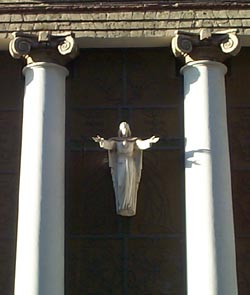 The
Monday after Easter is called "Monday of the Angel," in Italian, but,
more commonly, "Pasquetta"—a diminutive of "Pasqua"—Easter.
It commemorates the meeting (recounted in the Bible, above) of the risen
Christ with his disciples in Emmaus, a village near Jerusalem, on the
Monday after the Resurrection. To recall the disciples' walk from Jerusalem
out to the nearby village, it is still customary in many parts of Italy
for people—especially young people—to go on an outing. The
Monday after Easter is called "Monday of the Angel," in Italian, but,
more commonly, "Pasquetta"—a diminutive of "Pasqua"—Easter.
It commemorates the meeting (recounted in the Bible, above) of the risen
Christ with his disciples in Emmaus, a village near Jerusalem, on the
Monday after the Resurrection. To recall the disciples' walk from Jerusalem
out to the nearby village, it is still customary in many parts of Italy
for people—especially young people—to go on an outing.
This custom
easily makes Pasquetta the most hectic, bustling day of the year in
Naples. Last–minute Christmas shopping, Mardi Gras celebrations,
New Year's Eve, rowdy bands of football hooligans—all of that
is nothing compared to the Monday after Easter. Every single teenager
who is upright and breathing puts on a knapsack packed with food and
sets out to go somewhere—anywhere. But not alone. They travel
in packs, herds, swarms, or whatever the appropriate collective noun
is for a carefree mob out for a picnic in celebration of a religious
event they no longer remember anything about.
 The
Biblical verses tell us that Emmaus was about "threescore furlongs"
from Jerusalem. If the translators of the King James Bible and I are
using the same single AA-cell-driven calculator, that rounds off to
about 7½ miles. It goes without saying that Neapolitan teenagers
of today are not about to walk 7½ miles to commemorate anything,
but they will take the train. The local narrow-gauge iron horse that
runs from Naples to Sorrento is called the Circumvesuviana. It makes
almost 30 stops on the way out; many of these stations are on the slopes
of Vesuvius in what is the most-densely populated area in Europe. All
of these kids populate densely onto that train on Pasquetta and go somewhere.
I have been on the train on Pasquetta and actually had kids come over
and sit on me! They will also take the boat. I have been on the ferry
to Capri on Pasquetta. We were packed to the gunwales with teenagers,
each of whom carried his or her own weight in obnoxious very loud portable
music toys—and I say that without even knowing where the gunwales
of a ship are located. The
Biblical verses tell us that Emmaus was about "threescore furlongs"
from Jerusalem. If the translators of the King James Bible and I are
using the same single AA-cell-driven calculator, that rounds off to
about 7½ miles. It goes without saying that Neapolitan teenagers
of today are not about to walk 7½ miles to commemorate anything,
but they will take the train. The local narrow-gauge iron horse that
runs from Naples to Sorrento is called the Circumvesuviana. It makes
almost 30 stops on the way out; many of these stations are on the slopes
of Vesuvius in what is the most-densely populated area in Europe. All
of these kids populate densely onto that train on Pasquetta and go somewhere.
I have been on the train on Pasquetta and actually had kids come over
and sit on me! They will also take the boat. I have been on the ferry
to Capri on Pasquetta. We were packed to the gunwales with teenagers,
each of whom carried his or her own weight in obnoxious very loud portable
music toys—and I say that without even knowing where the gunwales
of a ship are located.
All that
may be in keeping with something I've just read about Easter Monday—that
early Christians celebrated the days immediately following Easter by
telling jokes and playing pranks. I had never heard that before, and
I am not sure how much better off I am now that I know it. In any event,
the disciples did not enjoy such modern amenities as portable CD players
and cell-phones beeping in 20 different keys at the same times. One
wonders how they passed the time on their walk. The best thing to do
on Easter Monday in Naples is stay home.
San
Domenico Maggiore, Piazza
One of
the most interesting squares in the city of Naples is Piazza San
Domenico Maggiore. The square is on "Spaccanapoli" (named via
Benedetto Croce at this particular section of its considerable length)
the street that "splits" the historic center of Naples and that was
one of the three main east-west streets of the original Greek city of
Neapolis.
In the
center of the square is an obelisk topped by a statue of San Domenico
di Guzman, founder of the Dominican Order, erected after the plague
of 1656. The original designer of the spire was the great Neapolitan
architect, Cosimo Fanzago, among whose other works is the San Martino
monastery on the hill overlooking the city. Construction on the spire
was started immediately after the plague epidemic of 1656 but was suspended
in 1680 when the spire had reached about half the height one sees today.
It was finished in 1737 under Charles III, the first Bourbon monarch
of Naples.
 The most prominent
building on the square is, of course, the Church of San Domenico Maggiore
(photo on left) . The church one sees today incorporates a smaller,
original church built on this site in the tenth century, San Michele
Arcangelo a Morfisa, a Byzantine church that housed the Basilian monastic
order. The original entrance is still visible to the left in the square
at the top of an outside stairway (seen in the next photo, below). After
the Schism between Rome and Constantinople, that church became a Benedictine
monastery in 1116 and then passed to the Dominican order in 1221. Charles
II of Anjou began the extensive rebuilding that produced the Church
of San Domenico Maggiore. The work was done between 1283 and 1324, but
the church has undergone extensive modifications over the centuries,
including one in 1670 that recast the structure in the style of the
Baroque. In the 19th century, however, the church was restored to its
original Gothic design. The most prominent
building on the square is, of course, the Church of San Domenico Maggiore
(photo on left) . The church one sees today incorporates a smaller,
original church built on this site in the tenth century, San Michele
Arcangelo a Morfisa, a Byzantine church that housed the Basilian monastic
order. The original entrance is still visible to the left in the square
at the top of an outside stairway (seen in the next photo, below). After
the Schism between Rome and Constantinople, that church became a Benedictine
monastery in 1116 and then passed to the Dominican order in 1221. Charles
II of Anjou began the extensive rebuilding that produced the Church
of San Domenico Maggiore. The work was done between 1283 and 1324, but
the church has undergone extensive modifications over the centuries,
including one in 1670 that recast the structure in the style of the
Baroque. In the 19th century, however, the church was restored to its
original Gothic design.
Among the
many artistic points of interest in the basilica is the frescoed ceiling
by Francesco Solimena (1707), one of the most prominent of Neapolitan
Baroque painters. The church also holds the tombs of a number of Aragonese
princes from the fifteenth century. Other prominent figures repose here,
as well: for example, Cardinal Fabrizio Ruffo,
head of the loyalist Army of the Santa Fede, which brought down the
Parthenopean Republic in 1799.
The monastery
annexed to the church has been the home of prominent names in the history
of religion and philosophy. It was the original seat of the University
of Naples, where Thomas Aquinas, a former monk at San Domenico Maggiore,
returned to teach theology in 1272. As well, the philosopher monk, Giordano
Bruno, lived here before setting off on his wanderings as an itinerant
teacher.The side of San Domenico Maggiore on the square is actually
the front of the church, meaning that if you go in that entrance you
come up next to the altar, itself. The main entrance, from the back,
opens onto a courtyard within the monastery, itself, and is generally
not open.
The present-day
form of the square took shape between the 15th and 19th centuries, starting
with work done by the Aragonese, who transformed it into one of the
most important centers in the city. Bounding the square are a number
of prominent buildings in the medieval and, later, Spanish history of
the city.
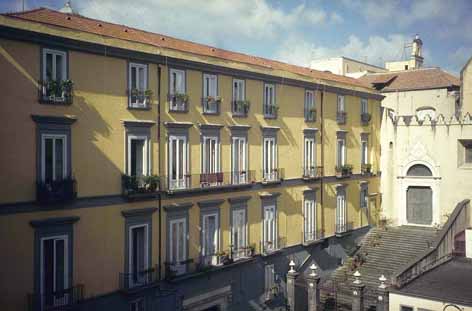 Next to the stairway on the left as you
face the church is Palazzo Balzo, now called Palazzo Petrucci
(photo on right). Its origins are in the early 14th century as a residence
of nobility connected with the move of the Angevin dynasty from Sicily
to Naples. It passed into the hands of Petrucci in the mid-1400s. Petrucci
enjoyed the favor of Ferrante, the Aragonese ruler of Naples, until
he joined the so-called "Barons' revolt" of 1485. He was executed by
decapitation. The building has changed hands many times since then,
and the only real remnant of the 14th century seems to be the main portal. Next to the stairway on the left as you
face the church is Palazzo Balzo, now called Palazzo Petrucci
(photo on right). Its origins are in the early 14th century as a residence
of nobility connected with the move of the Angevin dynasty from Sicily
to Naples. It passed into the hands of Petrucci in the mid-1400s. Petrucci
enjoyed the favor of Ferrante, the Aragonese ruler of Naples, until
he joined the so-called "Barons' revolt" of 1485. He was executed by
decapitation. The building has changed hands many times since then,
and the only real remnant of the 14th century seems to be the main portal.
 On the other side of the square is the Palazzo
Sangro di Sansevero (photo on left), built in the middle of the
16th century. The Palazzo was built in the second half of the 1500s
at the behest of Paolo di Sangro. The simple facade was embellished
in 1621 and is the one we see today. Over the ornate portals is the
crest of the Sangro di Severo family. The most famous of the family
is Raimondo di Sangro, Prince of Sansevero
(1710-71), whose scientific and technological research earned him an
excommunication and reputation for sorcery. On the other side of the square is the Palazzo
Sangro di Sansevero (photo on left), built in the middle of the
16th century. The Palazzo was built in the second half of the 1500s
at the behest of Paolo di Sangro. The simple facade was embellished
in 1621 and is the one we see today. Over the ornate portals is the
crest of the Sangro di Severo family. The most famous of the family
is Raimondo di Sangro, Prince of Sansevero
(1710-71), whose scientific and technological research earned him an
excommunication and reputation for sorcery.
The building
is one of those in Naples said to be haunted! In 1590, prince Carlo
Gesualdo, famous composer of madrigals, killed his wife, Maria d’Avalos,
and her young lover, don Fabrizio Carafa. They say that Gesualdo then
killed his own tiny son because of a resemblance, real or imagined,
to his wife's lover. After the murders, Gesualdo went on to compose
some of the most beautiful and innovative pieces in the madrigal repertoire.
He married a second time and died in Naples in 1614. Tradition says
that the ghost of his murdered wife still walks the halls of the building.
 The famous chapel of Sansevero is off the square in back of the
Palazzo, itself, and is more properly named the Chapel of Santa Maria
della Pietà, or Pietatella. It dates back to 1590 when the Sansevero
family had a private chapel built in what were then the gardens of the
nearby family residence, the Palazzo Sansevero. Definitive form was
given to the chapel by Raimondo di Sangro, famous Prince of Sansevero,
whose patronage added the frescos and sculpture, which would turn the
chapel into a harmonious and integral manifestation of religious faith
of the eighteenth century. Unique and world famous, of course, is the
statue of the Veiled Christ (photo on left), sculpted by Giuseppe
Sanmartino in 1753. The famous chapel of Sansevero is off the square in back of the
Palazzo, itself, and is more properly named the Chapel of Santa Maria
della Pietà, or Pietatella. It dates back to 1590 when the Sansevero
family had a private chapel built in what were then the gardens of the
nearby family residence, the Palazzo Sansevero. Definitive form was
given to the chapel by Raimondo di Sangro, famous Prince of Sansevero,
whose patronage added the frescos and sculpture, which would turn the
chapel into a harmonious and integral manifestation of religious faith
of the eighteenth century. Unique and world famous, of course, is the
statue of the Veiled Christ (photo on left), sculpted by Giuseppe
Sanmartino in 1753.
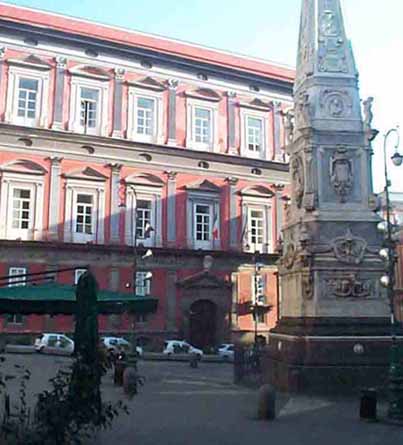 The Palazzo Sangro di Sansevero
is flanked by Palazzo Corigliano (photo on right), the building
on the corner of Spaccanapoli. Palazzo Corigliano got its name
in the 1700s from its most famous tenant, Duke Augustino di Corigliano,
but is much older than that. Construction started on Palazzo Corigliano
in 1506,at the very beginning of the Spanish viceroyship in Naples.
Sources from the 1600s and 1700s refer to it as one of the first truly
modern buildings in the city. Originally, the building had two stories,
but a third was added in the 1700s by the owner, Agostino Saluzzo. Almost
all of the sculpture and decorative murals within Palazzo Corigliano
stem from the 1730s. Spectacular and representative as they are of the
period, they are considered virtually in a class by themselves in Naples.
Quite recently, after extensive renovation, Palazzo Coriglno
has served to house some departments of the Orientale University of
Naples. The Palazzo Sangro di Sansevero
is flanked by Palazzo Corigliano (photo on right), the building
on the corner of Spaccanapoli. Palazzo Corigliano got its name
in the 1700s from its most famous tenant, Duke Augustino di Corigliano,
but is much older than that. Construction started on Palazzo Corigliano
in 1506,at the very beginning of the Spanish viceroyship in Naples.
Sources from the 1600s and 1700s refer to it as one of the first truly
modern buildings in the city. Originally, the building had two stories,
but a third was added in the 1700s by the owner, Agostino Saluzzo. Almost
all of the sculpture and decorative murals within Palazzo Corigliano
stem from the 1730s. Spectacular and representative as they are of the
period, they are considered virtually in a class by themselves in Naples.
Quite recently, after extensive renovation, Palazzo Coriglno
has served to house some departments of the Orientale University of
Naples.
The square
is closed on the south side by the Palazzo Casacalenda, an 18th century
building erected on the site of an ancient Greek temple, remnants of
which can be seen within the courtyard.
Wine
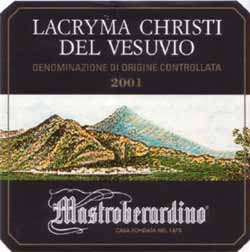 We
had a bottle of good wine some time ago right down on the water's edge
of Lake Averno, the place of the fabled
descent into the Inferno (from the name "Averno," by the way). Our host
told us that his vineyard and a few others down along the slopes of
the lake and in a few other places in Italy produced unusual wine for
this day and age in Europe; this is because they enjoy the same soil
characteristics (having to do with nearby volcanoes and other subterranean
goings-on). We
had a bottle of good wine some time ago right down on the water's edge
of Lake Averno, the place of the fabled
descent into the Inferno (from the name "Averno," by the way). Our host
told us that his vineyard and a few others down along the slopes of
the lake and in a few other places in Italy produced unusual wine for
this day and age in Europe; this is because they enjoy the same soil
characteristics (having to do with nearby volcanoes and other subterranean
goings-on).
Such locations
remained immune to the devastating winepest that spread though European
vineyards in the late 1800s. The disease was the result of the Phylloxera
aphid, which wiped out many European vineyards. As it turned out,
the roots of American vines were immune to Phylloxera, so European
wine makers grafted their vines onto American roots to make them less
vulnerable to the disease. That saved the European wine industry. But
down on Lake Averno, we had some good grape that had never had to be
revived. The gentleman showed us a vine that he claims is 250 years
old. It is a solid, almost tree-trunk-like affair as it comes out of
the ground and is the mother vine for the entire vineyard. I don't know
if "mother vine" is legitimate terminology. The Italian word is vitigno,
which they distinguish from the smaller, secondary vine—vite—that
runs through the vineyard and actually sprouts grapes. There seem to
be two words for "vineyard," as well: vigna and vigneto.
I don't think there is a difference.
I had not
set out to learn anything about Phylloxera. I started out looking
for strange names of wines, and, as usual, wandered away into a thicket
of miscellany. The most unusual name for a wine that I have ever heard
actually belongs to a German wine. It is called Croever Nacktarsch,
which is usually translated euphemistically as "bare bottom," but the
term in German is as vulgar as anyone who can read English might imagine
it to be. Croev is a town on the Middle Moselle between Zell and Traben
Trarbach in Germany. The label of the wine shows a small boy being spanked
on his bare behind by the inn-keeper, who has just caught the lad down
in the cellar doing some pre-pubescent wine tasting.
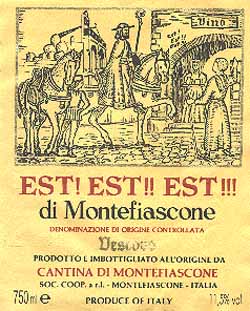 My
vote for the most amusing name for an Italian wine goes to Est! Est!
Est! —Latin for "This is it! This is it! This is it!" It seems
that in the year 1111, Henry V of England was on his way to Rome to
be crowned by the Pope. In his entourage was one Giovanni Deuc, a lover
of fine wine. Near Montefiascone (not far from Lake Bolsena, near Orvieto,
in central Italy), Giovanni sent his servant, Martin, ahead to scout
the potential for bibbing. The instructions were, "When you find the
good stuff, scrawl 'Est!' on the door of the tavern, so I know where
to stop." Marty was so impressed with one vintage that he waxed redundantly
enthusiastic and emblazoned "Est! Est! Est!" on the door. Giovanni
apparently drank himself to death right on the spot. He left money to
the town of Montefiascone to commemorate his fatal binge: every year,
a bottle of Est! Est! Est! is poured on his tomb, where there
is still the legible inscription: "From too much Est!, here lies
my lord, Giovanni Deuc." I hope that's a true story; anyone who would
make that up must have been drinking. My
vote for the most amusing name for an Italian wine goes to Est! Est!
Est! —Latin for "This is it! This is it! This is it!" It seems
that in the year 1111, Henry V of England was on his way to Rome to
be crowned by the Pope. In his entourage was one Giovanni Deuc, a lover
of fine wine. Near Montefiascone (not far from Lake Bolsena, near Orvieto,
in central Italy), Giovanni sent his servant, Martin, ahead to scout
the potential for bibbing. The instructions were, "When you find the
good stuff, scrawl 'Est!' on the door of the tavern, so I know where
to stop." Marty was so impressed with one vintage that he waxed redundantly
enthusiastic and emblazoned "Est! Est! Est!" on the door. Giovanni
apparently drank himself to death right on the spot. He left money to
the town of Montefiascone to commemorate his fatal binge: every year,
a bottle of Est! Est! Est! is poured on his tomb, where there
is still the legible inscription: "From too much Est!, here lies
my lord, Giovanni Deuc." I hope that's a true story; anyone who would
make that up must have been drinking.
In the
Naples area, the most interesting name for a wine is Lachryma Christi
(Tears of Christ). It is produced on the fertile slopes of Vesuvius,
and the wine is so named because it is here, they say, that Lucifer
was cast out of heaven, causing Christ to weep. The funniest name for
a local wine comes from Ischia, where they drink Pere 'e palummo,
dialect for "Foot of the dove," so called because the ruby-red color
of the stems of the vine recalls the coloring of that particular bird's
foot. A likely story? Maybe.
Dante, Piazza
 Piazza Dante is a bit of welcome wide-open space in a city notoriously
lacking in elbow room. It was closed for a few years while they built
the new Metropolitana underground train station. Now that that is finished,
it was well worth the wait for two reasons: one, it's a place to sit
down or stroll around a bit in the middle of a busy city, and, two,
the square is now conveniently connected to the Vomero section of town
a few miles away and 600 feet higher in elevation. Piazza Dante is a bit of welcome wide-open space in a city notoriously
lacking in elbow room. It was closed for a few years while they built
the new Metropolitana underground train station. Now that that is finished,
it was well worth the wait for two reasons: one, it's a place to sit
down or stroll around a bit in the middle of a busy city, and, two,
the square is now conveniently connected to the Vomero section of town
a few miles away and 600 feet higher in elevation.
This square,
named for one of the greatest names in world literature, is dominated
by a 19th-century statue of the poet, sculpted by Tito Angelini. Long
ago the square was called Largo del Mercatello—simply,
Market Square—and, then, in 1765 was rechristened "Foro Carolina,"
after the wife of the King of Naples. At that time, the original square
was greatly modified by Luigi Vanvitelli. The ornate semicircular arrangement
of columns and statues was originally intended to depict the virtues
of Charles III, the first Bourbon king of Naples; the niche in the center
was to have been dedicated to the monarch. It now, however, marks the
entrance to a boarding-school named for Victor Emanuel II. Piazza Dante
was the site of the Cafe Diodato, a gathering place of actors at the
end of the 19th century, who, during the summer months would perform
on a stage set up amid the tables.
Facing
the great semicircular building, one sees Port'Alba on the left.
Port'Alba was an old city gate, moved in the 17th century by
the Spanish viceroy Duke d'Alba Antonio Alvarez de Toledo, and incorporated
into the restructured Foro Carolina. On the right is the Church of San
Michele, and across from the square is the Church of San Domenico Soriano
with its adjacent convent, now housing the municipal registry office.
Poor Dante
was moved 100 meters away in order to accommodate the construction of
the new station, but now he is back center-stage and sand-blasted clean
as a whistle.
Geology
(2), volcanoes (2)
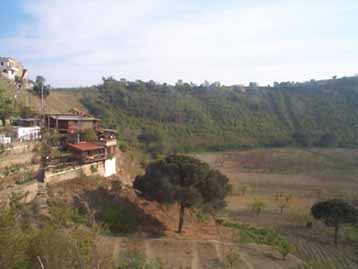 Somehow I admire people who live in volcanoes or at
least on the slopes of volcanoes, even when they're extinct (the volcanoes,
not the people). Yesterday we had lunch in a delightful restaurant on
the inside slope of a crater, out in Baia, just past the bay of Pozzuoli.
It is at the end of the Campi Flegrei—the "Fiery Fields"—in
parts, a still active and bubbling collection of thermal baths and sulfur
fumaroles, but for the most part a welter of extinct craters some millions
of years old. (The famous Pozzuoli caldera, however, is only 35,000
years old, and the nearby "Monte Nuovo"—New
Mountain—really is new, as mountains go; it surfaced in the 1500s. Somehow I admire people who live in volcanoes or at
least on the slopes of volcanoes, even when they're extinct (the volcanoes,
not the people). Yesterday we had lunch in a delightful restaurant on
the inside slope of a crater, out in Baia, just past the bay of Pozzuoli.
It is at the end of the Campi Flegrei—the "Fiery Fields"—in
parts, a still active and bubbling collection of thermal baths and sulfur
fumaroles, but for the most part a welter of extinct craters some millions
of years old. (The famous Pozzuoli caldera, however, is only 35,000
years old, and the nearby "Monte Nuovo"—New
Mountain—really is new, as mountains go; it surfaced in the 1500s.
The restaurant
was a three-level affair clinging to the slope (photo), making up in
vertical space what it lacked in horizontal. From the terrace, you could
look across and see other optimists clinging to their bit of slope across
the way. You could look down and see a farmhouse at the bottom. It was
set in a nice stand of trees, and there was a small vineyard down there,
as well.
The residents
are not in any actual danger because the craters really are extinct.
On the other hand, on the eastern side of the city of Naples, Mt. Vesuvius
last erupted in 1944 and is now described as "quiescent". I think that
term describes a condition somewhat more threatening than "dormant".
I know that the Vesuvius Observatory updates their webpage on a daily
basis, reminding you of the number of "seismic events yesterday," for
example. Most of the "events" are not noticed by human senses, but sensors
indicate a significant amount of activity. They say there is a "plug"
building up about 6 miles below the crater. The real optimists are the
ones who built on that slope right after the eruption half a century ago and who continue to
build and lead their lives with complete, fatalistic disdain for what
the future might hold. Last year, the collective communities around
Vesuvius considered it important to have a practice evacuation of the
area. They chose, as I recall, 500 volunteers and said "Go!". The make-believe
refugees from a make-believe eruption then followed the planned evacuation
routes to safety. It went well. Evacuating almost a million people in
the real thing would be a different matter, I'm afraid. Perhaps the
only point for true optimism is that Vesuvius is one of the best monitored
volcanoes in the world. It is unlikely that there would be no warning
at all of an impending eruption.
[Click
here for a separate item on the "Geology of the Bay of Naples".]
Monuments
in May
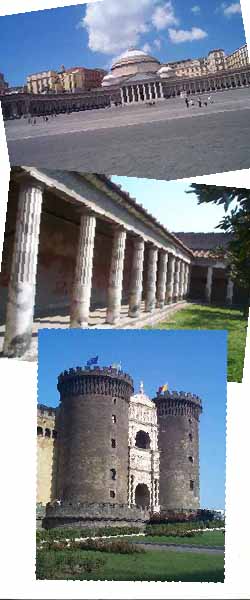 This
weekend will mark the beginning of the "Monuments in May" festivities
in Naples. It's a month-long bath of culture, an attempt to open everything
in the city that can be opened—all the museums, churches, and
archaeological sites. The larger ones are usually open all year round,
but in May the city makes an extra effort to put the city's considerable
cultural wealth on display for tourists. This
weekend will mark the beginning of the "Monuments in May" festivities
in Naples. It's a month-long bath of culture, an attempt to open everything
in the city that can be opened—all the museums, churches, and
archaeological sites. The larger ones are usually open all year round,
but in May the city makes an extra effort to put the city's considerable
cultural wealth on display for tourists.
Many of
the sites are separated into "itineraries," broken down by centuries,
with maps and markers indicating that this or that church is part of
the "17th–century route," for example. The ancient archaeological
sites outside the city, such as Herculaneum and Pompeii, of course,
need no introduction; lesser known ones, such as Oplontis
(near Pompeii) and the excavated Roman market below the church of San Lorenzo at the crossroads of the historic center
of the Naples, itself, can expect tourist traffic much heavier than
usual. Unusual sites—the Bourbon Poorhouse, for example—what was to
be a self-contained and self-sustaining institution for the indigent
in the 17th and 18th centuries, and is today a five-story, 300-meter-long
white elephant dozing in the sun at Piazza Carlo III—will also
be open. This is the month you can get in to walk through the ancient
Seiano tunnel beneath Posillipo from
the Bagnoli entrance all the way through and up onto some wealthy gentleman's
private property on the Posillipo side, which features the ruins of
a Greek amphitheater that, 2,000 years ago, belonged to Vedius Pollio,
a wealthy Roman gentleman in his own right.
The papers
are already complaining about the confusion. A reporter from Il Mattino
claims he stood in beautiful wide-open Piazza Plebiscito in front of the Royal Palace for
one hour and counted 119 motor-scooters racing across and around the
square, nominally a pedestrian zone. The front page featured a photo
of one young thug, reared up on the back wheel of his bike and doing
a "wheelie" across the square. Not a cop in sight, said the paper. Piano
wire stretched at neck level might help make up for the city's lack
of commitment to make Naples more visitable. The reporter didn't say
that; that's just a friendly suggestion.
Pulcinella
 On a wall in the Cave
of Les Trois Ariège in France there is a stone-age drawing of
a sorcerer wearing a mask. From his time to ours, from him to our own
children modestly disguised for Halloween, or revelers made up for carnevale,
there is an unbroken chain of masks. Made of every and anything from
mud to gold, they have served to frighten, delight, beg, accompany the
dead, cast out demons, and conceal lovers and executioners. From Greek
drama to Balinese trance-dancers to modern psychodrama in which actors
wear masks of their own faces, in every culture and in all of history,
there have been masks. On a wall in the Cave
of Les Trois Ariège in France there is a stone-age drawing of
a sorcerer wearing a mask. From his time to ours, from him to our own
children modestly disguised for Halloween, or revelers made up for carnevale,
there is an unbroken chain of masks. Made of every and anything from
mud to gold, they have served to frighten, delight, beg, accompany the
dead, cast out demons, and conceal lovers and executioners. From Greek
drama to Balinese trance-dancers to modern psychodrama in which actors
wear masks of their own faces, in every culture and in all of history,
there have been masks.
The mask
took on new meaning at the end of the 16th century in Italy, when there
arose a form of theatre known as the Commedia dell'Arte. The
actors were skilled in the representation of well-defined characters,
characters who appeared and reappeared, bearing the same name, wearing
the same mask and costume, speaking the same language and, thus, establishing
themselves as distinct character types, stereotypes of various regions
througout Italy. For example, the stereotypical mask of Bologna is the
pseudo-intellectual windbag, Dr. Balanzone, and Venice gives us the
greedy and conniving underling, Arlecchino.
One of
the best-known Italian masks is the one that represents Naples, Pulcinella.
He is generally presented as a hunchback (remember that male hunchbacks
are considered lucky in Naples!); he is dressed in a large, white smock
and soft white hat, and wears a black half-mask characterized by a hook-nose.
His character type is that of the jolly bungler, always poor and hungry,
yet always able to get by, singing songs and playing the mandolin.
In his stereotypical ineptness, however, there always remains the touch
of the true court jester, the "fool," who delights in snubbing his nose
at the powers that be, without their ever really catching on to how
much wisdom is hidden behind the mask.
It is that
anti–establishment part of Pulcinella's personality, the total
disrespect of authority that seems to be not so hidden in much modern-day
Neapolitan behavior. That's the reason—say some—that Neapolitans
drive they way they do. The state put that traffic light on the corner,
telling you when to go and when to stop. A free citizen is almost honor–bound
to ignore it.
San
Martino, Sant'Elmo
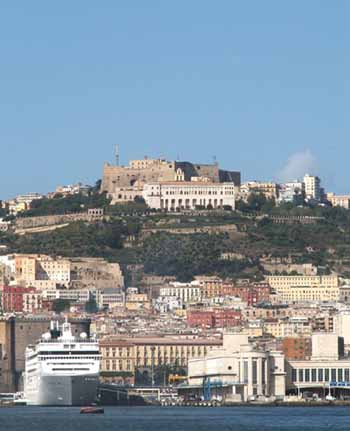 Seen
from the sea, the most visible structures in Naples are the museum of
San Martino and the fortress of Sant' Elmo, located on the Vomero hill
at the highest point in the city. The museum used to be a monastery
that was finished and inaugurated under the rule of Queen Giovanna I
in 1368. It was dedicated to St. Martin, bishop of Tours. During
the first half of the sixteenth century, propelled by the energies of
the Counterreformation, it was expanded. Later, in 1623, it was further
expanded and became, under the direction of architect Cosimo Fanzago,
the quintessentially Baroque structure one sees today. Fanzago was responsible
also for the small cemetery in the courtyard; a cemetery ornamented
by rows of skulls, a typical Counterreformation memento
mori—a reminder of mortality. Seen
from the sea, the most visible structures in Naples are the museum of
San Martino and the fortress of Sant' Elmo, located on the Vomero hill
at the highest point in the city. The museum used to be a monastery
that was finished and inaugurated under the rule of Queen Giovanna I
in 1368. It was dedicated to St. Martin, bishop of Tours. During
the first half of the sixteenth century, propelled by the energies of
the Counterreformation, it was expanded. Later, in 1623, it was further
expanded and became, under the direction of architect Cosimo Fanzago,
the quintessentially Baroque structure one sees today. Fanzago was responsible
also for the small cemetery in the courtyard; a cemetery ornamented
by rows of skulls, a typical Counterreformation memento
mori—a reminder of mortality.
Under the
French, the monastery was closed in 1806
and was abandoned by the religious order. Today, the museum houses a
museum with a fine display of Spanish and Bourbon
era artifacts, as well as a recently restored presepe, or Nativity
scene, a display made up of thousands of finely wrought eighteenth-century
Christmas figures. It is the finest display of its kind in the world.
(Click here for more about the presepe.)
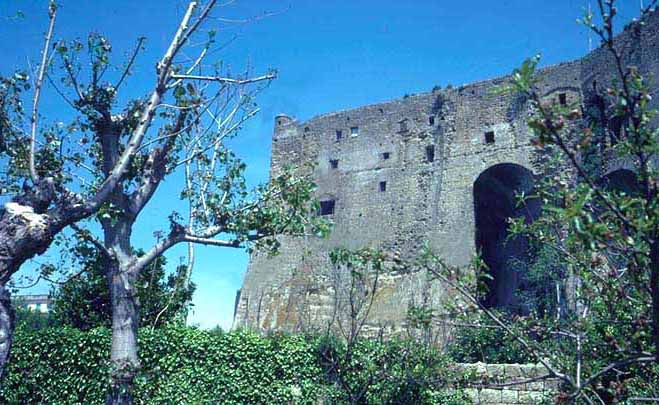
Sant’
Elmo is the name of both the hill and the fortress adjacent to the museum.
The name is from an old church, Sant’ Erasmo, that name being
shortened to "Ermo" and, finally, "Elmo".* The fortress was first started
in 1329 under Robert of Anjou and completed in 1343, the year of his
death. The strategic importance of the fortress was clear, and
the Spanish viceroy, Don Pedro de Toledo, had it rebuilt between 1537
and 1546. It was partially destroyed in 1587 when a lightning strike
caused the ammuntion dump to explode, killing 150 men in the process.
During the revolution of 1647, so-called “Masaniello’s
Revolt,” the Spanish viceroy took refuge in the fortress to
escape the revolutionaries. The people stormed the fortress but failed
to take it.
Sant’Elmo
was a dramatic symbol of the short, turbulent period of the Parthenopean
Republic, the local version of the French Republic. The fortress was
taken by the populace in 1799 and the Republic was proclaimed. A few
months later, the revolutionaries were forced to capitulate to Royalist
forces under Cardinal Ruffo. For a short
period, Sant’Elmo had been a bastion of freedom against Bourbon
absolutism; now it proved to be the prison and place of execution for
a number of the Republic’s supporters.
[*I
gratefully acknowledge some etymological information I have received
from Libero Scinicariello of Cleveland, Ohio: "... just a few miles
up the road in Gaeta, Erasmo is the patron saint and the namesake for
the Duomo. In local dialect, Erasmo evolved into Raimo, and the
church is referred to as Santu Raimo."]
Customs,
new & old; San Gennaro (3), Mark Twain
In The
Innocents Abroad, Mark Twain ridicules the miracle of San Gennaro
(click here to read the entire
excerpt) —that is, the miraculous liquefaction of the blood of
San Gennaro—as "…one of the wretchedest
of all the religious impostures one can find in Italy". One of the two
days on which that miracle is believed to occur is coming up: the first
Sunday in May. I don't pass judgment on miracles or others' belief in
such. If I did, I would find a real job somewhere as a Miracle Judgment
Passer or something like that.
Twain also
mentions another, rather curious, custom that I have enquired about
but been unable to shed any light on. He says:
| And
here, also, they used to have a grand procession, of priests,
citizens, soldiers, sailors, and the high dignitaries of the City
Government, once a year, to shave the head of a made up Madonna
– a stuffed and painted image, like a milliner’s dummy—whose
hair miraculously grew and restored itself every twelve months.
They still kept up this shaving procession as late as four or
five years ago. |
That would
make it about 1865. I have asked, and no one seems to know anything
about it. Maybe they made up the story to feed his cynicism. Customs
come and go, so I suppose it is quite possible that that one really
did exist and simply fell by the wayside. There are also recent customs
that probably seem ancient to young children, but the origins of which
are within living memory. Another
entry mentions the "Wishing Tree," a Christmas tree set up in the
center of the Galleria Umberto in December; you scrawl your wish for
the coming year on a slip of paper and stick it on one of the branches.
The custom of Christmas trees didn't find its way into this part of
Italy until after WW2, so that would be an example of a recent custom.
It is also an interesting example of combining something new—the
tree—with something old—the votive slips of paper, which
can show up at almost any religious shrine in Naples and even on some
non-Christian statuary, such as the statue of the Nile God in the historic center of
the city.
This morning
I noticed that someone is trying to invent a new custom. I was down
at the Gambrinus Café off of Piazza Plebiscito, and I
noticed a picture of Mt. Vesuvius on the wall. So far, nothing out of
the ordinary. Below the picture, however, was a written invitation to
"make your wish to Vesuvius" and to deposit the slip in the box provided
on the table next to the picture. Making a wish to Vesuvius? That is
unheard of, I believe, until invented by the proprietor of the café
as some sort of a commercial gimmick. I have never heard of any custom
that involves invoking the great god of the volcano (or some such Polynesia-like
deity) in Naples. As far as I know, they don't sacrifice goats or virgins
up there, either, both of which are in short supply in the area, anyway.
Maybe in a few years, it will be a custom. Like old proverbs—someone
has to come up with these things.
Salas,
Esteban; music (5)
 One
of the most unusual references to Neapolitan music that I have ever
come across was in a music catalogue; there was a short blurb
for a CD of music by Esteban Salas, "a composer of the Cuban-Neapolitan
Baroque". That, of course, piqued my interest. Who could have ever imagined
such a thing as a Cuban-Neapolitan Baroque connection? (Actually, with
a bit of reflection, it isn't at all bizarre: Cuba and Naples were both
part of the same Spanish Empire.) I sent away for the item and am very
happy that I did so. It is called Esteban Salas, Cuban Baroque Music
of the XVIII Century and is a recording from 1995, a collection
of the composer's Christmas carols performed by the Exaudi Choir of
Cuba. The music is beautiful—so delightful and effortlessly innocent
that it just seems to sing itself. It is one of the unfortunate quirks
of history that Salas is obscure today. One
of the most unusual references to Neapolitan music that I have ever
come across was in a music catalogue; there was a short blurb
for a CD of music by Esteban Salas, "a composer of the Cuban-Neapolitan
Baroque". That, of course, piqued my interest. Who could have ever imagined
such a thing as a Cuban-Neapolitan Baroque connection? (Actually, with
a bit of reflection, it isn't at all bizarre: Cuba and Naples were both
part of the same Spanish Empire.) I sent away for the item and am very
happy that I did so. It is called Esteban Salas, Cuban Baroque Music
of the XVIII Century and is a recording from 1995, a collection
of the composer's Christmas carols performed by the Exaudi Choir of
Cuba. The music is beautiful—so delightful and effortlessly innocent
that it just seems to sing itself. It is one of the unfortunate quirks
of history that Salas is obscure today.
Esteban
Salas y Castro was born in Havana on Christmas Day in 1725 and died
in Santiago de Cuba in 1803. He parents were natives of the Canary Islands
and, thus, musicologists list Salas as one of the first important native
composers of the New World. He started the study of music at age 11
and by the end of his long career had composed hundreds of liturgical
pieces. He also taught philosophy and theology.
The Neapolitan
connection, mentioned above, comes from the fact that Cuba—the
"Pearl Beyond the Sea"—and the Kingdom of Naples were both part
of the Spanish Empire. The Spanish ruled Naples as a vicerealm from
1500 to 1700 and are responsible for establishing the important music conservatories in Naples in the mid-1500s. It
is logical that the Spanish exported their culture to the rest of the
empire, as well—a music school in Havana, for example. (Now that
I pursue this line of thought, perhaps they established such schools
even in the Philippines. That is something I shall have to find out).
This, then,
from the liner notes of the CD:
| …We know nothing of his masters, nor
how he acquired
all the refinements of his art. It is possible that a certain Cayetano
Pagueras of Barcelona, a seafarer but also a good musician and singer,
had passed on to Salas the astonishing technique apparent throughout
his
compositions. In 1750 he had sailed from Spain to Cuba…He may have
furnished
Salas with scores…accessible to musicians in Spain at that period:
those
by Porpora, Paisiello, Alessandro Scarlatti and other 18th century
Neapolitan
masters (for Naples then belonged to Spain), notably those by Francesco
Durante, the harmonies and styles of which are present in those of
Salas… |
|
